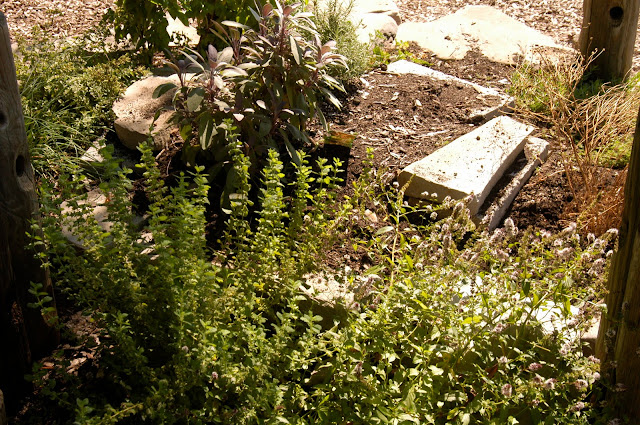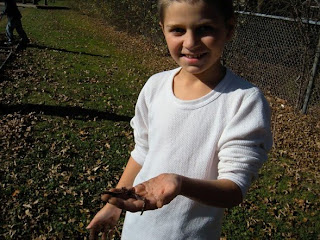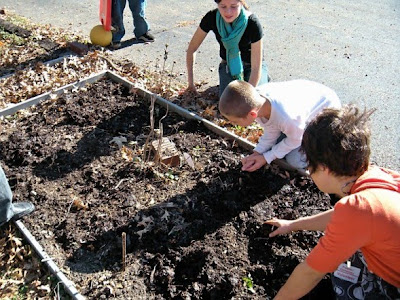today we bundled in sweaters and planted garlic at recess time!
Garlic is a member of the allium family which also includes leeks, shallots and onions. Individual cloves act as seeds. The bulbs grow underground and the leaves shoot in to the air. Although garlic is traditionally thought of as a Mediterranean ingredient garlic is also grown successfully in colder more Northern climates.
There are many different garlic varieties, a lot of which you can easily grow at home for a great crop.
How to Grow Garlic at Home
Garlic is grown from the individual cloves. Each clove will produce one plant with a single bulb - which may in turn contain up to twenty cloves. Growing garlic is therefore self-sustaining. When planting garlic, choose a garden site that gets plenty of sun and where the soil is not too damp. The cloves should be planted individually, upright and about an inch (25 mm) under the surface. Plant the cloves about 4 inches (100 mm) apart. Rows should be about 18 inches (450 mm) apart.
As garlic reaches maturity, the leaves will brown then die away. This is the cue that it is time to harvest your garlic crop. If you harvest too early the cloves will be very small, too late and the bulb will have split.
When to sow
warm temperate areas - generally speaking, it can be planted in autumn through to early winter. Under warm temperate climatic conditions autumn planted garlic will remain dormant for a few weeks, then develop roots and a shoot. With the onset of the cold of winter growth is fairly slow until temperatures warm in spring. The cold of winter is needed to initiate the side buds that will ultimately grow and swell to become cloves (and in some types, to initiate the flower bud). The lengthening days of spring are the signal for the initiated but undeveloped side buds to start forming into cloves. It is possible to sow in early spring and get a reasonably good harvest, but everything is against you - wet, difficult to work soil; no early root growth; less exposure to winter chill. Early Spring is possible, but definitely a second choice.
Temperate areas- plant after the first good frosts of autumn. Spring planting is possible in the higher latitudes, as the longer day lengths promote bulbing, but the shorter season means the bulbs are often smaller. Autumn garlic will produce roots, but either no, or short, top growth. If the garlic sprouts have emerged, they will survive freezes and snowfalls, but they should be mulched heavily (about 15 cm/6 inches) to prevent heaving. Pull the mulch aside in spring. Autumn planted garlic will have strong roots by winters icy grip, and these roots will help prevent the 'seed' being pushed out of the ground as the soil alternately freezes and thaws ('frost heave').
How to sow
Choose the biggest and fattest seed cloves, and sow them root end down, standing erect, and far enough in the soil that they are anything from just buried to being 25 mm/an inch or so under the soil surface. Put them about 100 mm/4 inches apart.
The tricks of growing satisfactory bulbs
Home grown garlic can be disappointing- small bulbs, bulbs with only one big soft clove, no bulb. The causes of unsatisfactory production come down to the quality of the 'seed', growing conditions, the variety, the vagaries of the season, and disease. give the best possible drainage. It is important to have a free draining soil. While cloves put in early in winter will have a longer cold treatment and will respond to lengthening days more quickly than those put in later, there is always a risk of the cloves rotting in a cold wet soil. Especially if the cloves are of dubious quality, or if you have a history of disease problems in your own saved seed cloves. Commercially, the seed cloves are often soaked in rugged fungicides prior to sowing to minimize this problem, but this is not an option for most of us. Excellent drainage is very important to give the edge on climate and disease.
give your plants an unreasonable advantage. Your garlic is likely in a race against root rotting disease and stem and leaf diseases. The better the leaf growth before bulbing starts, the bigger the bulb and the cloves will be. This translates to 'early care pays dividends later'. And also at the main growing stage, give your garlic every advantage to grow more than the disease will damage. Provide a free draining soil by amending it with sand, potting mix, well finished compost, leaf mould, or whatever. Consider a raised bed, or large tub culture. Before sowing, beef up the nutrient status of your soil by working in a complete fertilizer (5N - 10P - 10K) at about 225gms/half a pound per 7.5 Metres/25 feet of 30 cm/12 inch wide row. Once they have started growth in spring, give them regular - say fortnightly - very light side dressings of urea (or other high nitrogen fertilizer), spread 100 mm/6 inches either side of the plants. Liquid manures are also beneficial. Garlic competes poorly with weeds. Keep them as close to meticulously weeded as is possible. Be careful with the hoe- there is nothing more tragic than a beautifully growing garlic plant sliced off at soil level by a hurried hoe! If the weather is dry, mulch them to conserve water. Dry soil when the leaves are developing affects the yield quite badly, so water them well and regularly in dry periods.
The plants are ready to harvest when the foliage has died off, or mostly died off. If it is very wet near harvest time, consider lifting them a bit earlier and drying them under cover. Left in wet soil, the outer parchment often rots. And if there is disease in the root plate, it may develop too far and cause the bulb to fall apart when it is lifted. Rocambole is almost always ready to harvest a month or so before common garlic. But the state of the foliage is the indicator, not any particular date.


our sunflower seed harvest!





































